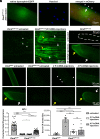Dystrophin myonuclear domain restoration governs treatment efficacy in dystrophic muscle
- PMID: 36595689
- PMCID: PMC9926233
- DOI: 10.1073/pnas.2206324120
Dystrophin myonuclear domain restoration governs treatment efficacy in dystrophic muscle
Abstract
Dystrophin is essential for muscle health: its sarcolemmal absence causes the fatal, X-linked condition, Duchenne muscular dystrophy (DMD). However, its normal, spatial organization remains poorly understood, which hinders the interpretation of efficacy of its therapeutic restoration. Using female reporter mice heterozygous for fluorescently tagged dystrophin (DmdEGFP), we here reveal that dystrophin distribution is unexpectedly compartmentalized, being restricted to myonuclear-defined sarcolemmal territories extending ~80 µm, which we called "basal sarcolemmal dystrophin units (BSDUs)." These territories were further specialized at myotendinous junctions, where both Dmd transcripts and dystrophin protein were enriched. Genome-level correction in X-linked muscular dystrophy mice via CRISPR/Cas9 gene editing restored a mosaic of separated dystrophin domains, whereas transcript-level Dmd correction, following treatment with tricyclo-DNA antisense oligonucleotides, restored dystrophin initially at junctions before extending along the entire fiber-with levels ~2% sufficient to moderate the dystrophic process. We conclude that widespread restoration of fiber dystrophin is likely critical for therapeutic success in DMD, perhaps most importantly, at muscle-tendon junctions.
Keywords: dystrophin-EGFP; mdx mouse; myotendinous junction; nuclear domain.
Conflict of interest statement
The authors declare no competing interest.
Figures




References
-
- Davies K. E., Nowak K. J., Molecular mechanisms of muscular dystrophies: Old and new players. Nat. Rev. Mol. Cell Biol. 7, 762–773 (2006). - PubMed
-
- Hoffman E. P., Brown R. H., Kunkel L. M., Dystrophin: The protein product of the Duchenne muscular dystrophy locus. Cell 51, 919–928 (1987). - PubMed
-
- Koenig M., Monaco A. P., Kunkel L. M., The complete sequence of dystrophin predicts a rod-shaped cytoskeletal protein. Cell 53, 219–228 (1988). - PubMed
-
- Schneider A.-F. E., Aartsma-Rus A., Developments in reading frame restoring therapy approaches for Duchenne muscular dystrophy. Expert Opin. Biol. Ther. 21, 343–359 (2021). - PubMed
-
- Goyenvalle A., et al. , Functional correction in mouse models of muscular dystrophy using exon-skipping tricyclo-DNA oligomers. Nat. Med. 21, 270–275 (2015). - PubMed
MeSH terms
Substances
LinkOut - more resources
Full Text Sources

